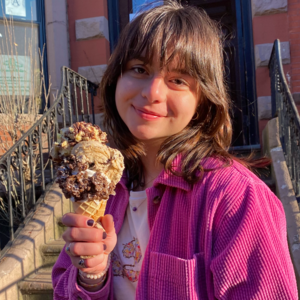In the world of extravagant lattes and desserts, there are few items that naturally flaunt neon colors without the help of artificial food coloring. For avid fans of adventurous drinks and Instagrammable meals, a natural phenomenon that’s bringing bright blue shades to your favorite fancy coffee shop: butterfly pea.
Butterfly pea is a flower that has been traditionally used in Asian herbal teas since before the 17th century. It then became trendy to Western audiences in 2016 where it was better known for being a versatile cocktail mixer. Now, butterfly pea is having a reappearance on TikTok through various viral videos demonstrating the colorful qualities of the flower for coffee and tea beverages.
What is butterfly pea?
Usually, butterfly pea flower is ground up into a powder to produce a vibrant herbal tea with an earthy flavor. Don’t get this confused with the other blue powder known for turning smoothie bowls azure on TikTok, known as spirulina, which is actually an algae. The butterfly pea flower is used to make tea, powder supplements, and many cosmetic products. The flower has various health benefits since it’s loaded with antioxidants, improves skin health, and is known to regulate blood sugar levels. Some people on TikTok have even made a variety of modern baked goods and creative recipes with the flower as an exciting color additive.
The dazzling cerulean, and sometimes blue-gray, product of the flower creates a childish sense of wonder that seems almost impossible. Even then, the butterfly pea flower offers another unusual attribute: the color of the flower changes depending on pH, or acidity. When adding an acidic mixer, such as lemon or pineapple, the tea’s classic blue color will darken to deep violet. When including hibiscus petals, tea turns into a hot fucshia. This quality makes for a fun party trick!
The history of butterfly pea:
The striking color of the powder might seem shocking to some, but butterfly pea is common in other parts of the world. The tea and flower itself are commonly served in its native habitat particularly in Vietnam, Thailand, and Indonesia. The plant has its origins across Southeast Asia, where it was then taken to India and later to Europe in the 17th century. The beverage is offered complimentary in many hotels, restaurants, and museums where it is better known as nam dok anchan in Thailand or Asian pigeonwings when mixed with honey and lemon.
Flavor-wise, butterfly pea is described as “subtle, earthy, and woody” and is an essential ingredient in certain Southeast Asian dishes such as nasi kerabu, a Malaysian blue rice plate. While the tea might be having a moment in the U.S., it’s essential to remember that it’s originally a Southeast Asian flavor that repeatedly appears in cultural recipes dating back to before the 17th century, more dishes including pulut inti, pulut tai tai, and nyonya chang.
Where to find butterfly pea:
Since a fad resurgence in 2016, the Western world is now full of coffee shops that have begun to see the potential of serving blue drinks that inevitably evoke awe in customers. Coffee shops serving up blue realness will usually be in more “trendy” urban locations like Remi43 Coffee in New York City or Cafe Georgetown in Washington D.C.
If you’re inclined to brew your own tea or incorporate the flower in a new recipe, the flowers can be purchased from herbal companies online such as Rishi or World Spice. Because it is grown in Southeast Asia, prices tend to be on the higher side due to shipping costs.


